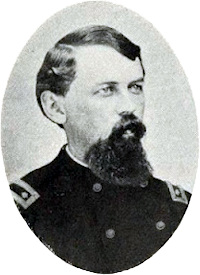One and three-quarter miles southwest of Atlanta,
July 29, 1864.
On the evening of the 26th, Adj. Frank Lermond sent me word that the Army of the Tennessee was going to evacuate its position, the movement to commence at 12 p.m. When the lines are so close together the skirmish line is a ticklish place.
The parties can tell by hearing artillery move, etc., nearly what is going on, and in evacuation generally make a dash for the skirmish line or rear guard. At nearly every position Johnston has fortified we caught his skirmish line when he evacuated. Luckily our line got off about 4 a.m. on the 27th though they shelled us right lively.
That day our three corps moved along in the rear of the 23d, 4th, 14th and 20th, the intention being, I think, to extend the line to the right, if possible, to the Montgomery and Atlanta railroad and thus destroy another line of communication. We have thoroughly destroyed 50 miles of the Augusta and Atlanta railroad. The 16th Corps formed its line on the right of the 14th, and the 17th joined on the 16th, and on the morning of the 28th, we moved out to extend the line still further. At 12 m. we had just got into position and thrown a few rails along our line, when Hood’s Rebel corps came down on Morgan L’s and our divisions like an avalanche. Our two divisions did about all the fighting, and it lasted until 5 p.m.
We whipped them awfully. Their dead they left almost in line of battle along our entire front of two divisions.
It was the toughest fight of the campaign, but not a foot of our line gave way, and our loss is not one-twentieth of theirs. The rails saved us. I am tired of seeing such butchery but if they will charge us that way once a day for a week, this corps will end the war in this section.
Our loss in the regiment was 17 out of 150 we had in the fight, and the brigade loss will not exceed 100. I never saw so many Rebels dead. We are in excellent spirits, and propose to take Atlanta whenever Sherman wants it.
